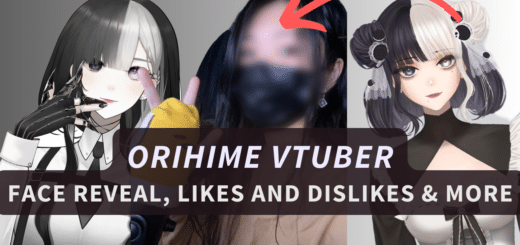Everything You Need To Know About VTubers
Hey there, Vishwas at your service! As the resident VTuber expert over at dereproject.com, I’m thrilled to bring you a comprehensive dive into the captivating world of virtual Youtubers. Get ready to explore this fascinating phenomenon with me!
I still vividly recall my initial encounter with VTubers several years ago. I was genuinely perplexed – why were these animated characters engaging with me through my computer screen? And how did they amass legions of devoted fans eagerly commenting on their live streams?
For the uninitiated, allow me to simplify it: a VTuber is essentially a Youtuber or online streamer who opts for an animated avatar to represent themselves instead of revealing their true identity. VTubers go all out, dressing up their avatar personas in outlandish outfits, curating their virtual surroundings, and entertaining their fans by singing, dancing, playing games and just chatting.
It’s a unique form of digital entertainment that could only thrive in the age of the internet, and it has achieved immense popularity by breaking away from conventional vlogging formats.
Over the past 5 years or so, VTubers have absolutely exploded, especially in Japan where the trend originated. But VTubers are now going global, with English-speaking virtual YouTubers gaining millions of subscribers worldwide. As an avid fan myself, I’ve gone deep down the rabbit hole and am excited to share everything I’ve learned!
Table of contents
- What Is A VTuber?
- Why VTubing Became Big
- VTubers in Japan vs. Other Countries
- The VTuber Fanbase
- VTuber Clippings
- Where To Find VTubers
- Major VTuber Agencies
- Major VTubers
- How To Become A VTuber Yourself
- VTuber Software
- Model Rigging
- How To Start A VTuber Agency
- Adjacent Markets
- My Predictions
- Frequently Asked Questions

What Is A VTuber?
At its essence, a VTuber is an individual who creates and streams video content while assuming the persona of a virtual character, commonly referred to as their avatar. What sets VTubers apart is their ability to seamlessly synchronize their avatar’s head movements and facial expressions with their own, all thanks to cutting-edge motion-tracking technology. This ingenious tech allows them to control their on-screen persona in real time while preserving their anonymity behind the digital veil.
The virtual avatar acts as the streamer’s online persona and brand. For viewers, it provides an eye-catching anime-style character to watch and interact with as the VTuber engages in a myriad of activities such as gaming, casual chats, performing original songs, and other content. It’s a creative way for the streamer to take on a specific look and personality different from their real self. Popular anime archetypes like energetic catgirls, cool heroes and mischievous tricksters are common inspirations for VTuber avatar designs.
Beneath the surface, VTubers employ computer vision technology to map their physical movements onto their avatar. Various tools come into play, including webcams, smartphones, and Kinect sensors, which track facial expressions and motion. More advanced setups involve the use of VR headsets, enabling full-body tracking for a heightened sense of immersion. Custom software then harmonizes these movements, delivering an avatar with synchronized actions during live streams.
This innovative setup empowers the streamer behind the avatar to unleash goofy antics and embody quirky personas, all while enjoying the comforting anonymity afforded by their virtual mask. For introverted entertainers, it can be an immensely liberating experience!
Why VTubing Became Big

When VTubers first burst onto the scene, they immediately captivated viewers with their fresh and innovative approach to entertainment. The sheer novelty of interacting with a vibrant anime character in real-time sets it apart from traditional streaming formats. It was a breath of fresh air that left audiences enchanted.
As content creators delved deeper into the boundless creative opportunities, they crafted distinct personas complete with captivating character designs, intriguing backstories, and entertaining streaming styles. These personas resonated particularly well with the anime and gaming enthusiast crowd. Fans found themselves drawn to the hardworking VTubers who consistently churned out engaging content.
The emergence of VTuber agencies like Hololive Productions and Nijisanji played a pivotal role in the movement’s growth. These agencies actively nurtured virtual talents, employing aggressive promotion and providing top-tier streaming assets. The result? A remarkable leap in production quality across the VTuber landscape.
With live audience participation being a core part of VTubing, fans felt connected to their oshis (short for oshihen, meaning “favorites”). VTubers skillfully read and responded to live chat comments, took fan suggestions, and celebrated fan art/creations. This cultivated a highly engaged core audience that returned day after day.
VTubers soon found themselves headlining massive live concerts in colossal venues, with tens of thousands of fans passionately cheering on their virtual idols. This spectacle solidified VTubing as a bona fide entertainment industry. Yet, at its heart, the close-knit camaraderie between VTubers and their devoted fans remained a cornerstone of the movement, ensuring its enduring appeal.
VTubers in Japan vs. Other Countries
The genesis and evolution of VTubing took root within the online communities of Japan, and this distinct origin has given rise to some notable disparities between Japanese VTubers and those hailing from overseas.
Japanese VTubers, influenced by the country’s idol culture, often adopt personas that are characterized by cuteness, demureness, and bashfulness. They draw heavily from familiar anime tropes and reference inside jokes that resonate with dedicated otaku fans. While this approach perfectly resonates with Japanese audiences who are well-versed in these tropes, some references may fall flat for foreign viewers.
Conversely, English-speaking VTubers tend to exude a greater level of confidence, embracing boisterousness, goofiness, and a healthy dose of internet culture memes to appeal to a worldwide audience. They seamlessly transition from being “seiso” (pure) one moment to embracing their inner “degenerates” the next. While Japanese VTubers lean into the kawaii aesthetics, their English-speaking counterparts might fully embrace edgy personas like shark girls or playful skeletons.
Another notable difference lies in the approach to fan interactions. Japanese VTubers often heavily promote parasocial relationships, employing intimate phrases like “I love you” with their fans, which is well-received in their culture. However, this approach can make many Western viewers uncomfortable. English-speaking VTubers, on the other hand, tend to maintain more emotional distance from their viewers.
There are also language barriers to break through. While some bilingual JP VTubers like Hakos Baelz cater content to English audiences, most speak exclusively Japanese. Thankfully fan translators and clip channels work hard to bridge the gap by adding subtitles and translating highlights.
Despite these cultural distinctions, VTubers from all corners of the world share a common goal: to provide enjoyable streaming content while donning their fun anime avatars. As the VTubing phenomenon continues to expand globally, we can certainly look forward to exciting cross-cultural collaboration streams in the future!
The VTuber Fanbase

Now you might be wondering – who exactly are the millions of fans watching VTubers for hours on end? Well, there’s no single unified profile of a VTuber fan, but they do share some common traits.
First and foremost, a substantial portion of VTuber fans hail from backgrounds steeped in anime and gaming culture, where idolizing cute 2D characters is second nature. For these fans, VTubers represents the perfect fusion of beloved anime waifus brought to life through interactive streaming.
Dedicated fans exhibit their unwavering support through various means, investing significant time and resources in bolstering their “oshi” (favorite VTuber). This support takes many forms, including daily viewership of streams, purchasing merchandise, becoming channel members, and even attending live events. The most ardent of fans have even been known to “marry” body pillows adorned with their favorite VTuber’s image!
Thanks to the instant feedback from live streaming, VTubers have cultivated an incredibly engaged core audience. Fans actively interact not only with their cherished oshis but also with fellow viewers in the stream chat, forging vibrant and tightly-knit communities. To bridge language barriers, fan translators play a crucial role by explaining Japanese streams to English-speaking viewers.
Of course, with such passionate devotion, there are occasional downsides, including incidents of toxicity directed towards VTubers who may inadvertently upset their fans and harassment of individuals deemed “antis”. However, for the most part, discussions surrounding VTubing occur peacefully in online communities like the subreddit r/VirtualYoutubers, where fans come together to share their enthusiasm and insights.
VTuber Clippings
Livestreaming several hours a day results in a treasure trove of content for each VTuber. To help fans navigate this sea of content, dedicated fan channels step in to create clips, extracting the finest gems and packaging them into easily consumable videos.
These skilled fan clippers specialize in editing together amusing reactions, remarkable gaming highlights, and heartwarming VTubing moments. This curated content serves as a gateway, introducing VTubers to new audiences on platforms like YouTube, all without the time commitment required for full-length streams.
Clip channels can focus their efforts on a single VTuber, such as the wildly popular Gawr Gura, or encompass entire agencies, like “hololive moments.” Some clippers even specialize in “shipping,” exploring romantic or close relationships between VTubers, while others provide invaluable translations and context to make the content accessible to overseas viewers.
Clippers get permission from VTubers before monetizing the derivative content. This allows full-time clip channels to profit from fan edits but is controversial due to copyright issues. Still, clipping is an essential part of the VTuber ecosystem connecting streamers and fans.
Sometimes even the official agency’s Youtube channels upload clip compilations like this:
Where To Find VTubers
So, you’re eager to dive into the world of VTubers? Great! Here’s where you can embark on your VTuber journey:
- YouTube: YouTube stands as the predominant platform for VTubers, offering livestreaming functionality and a wealth of archived content.
- Twitch: VTubers can also be found on Twitch, catering to a diverse audience and offering a different streaming experience.
- Twitter Spaces: Some VTubers utilize Twitter Spaces for live audio conversations and interactions.
- Other Streaming Sites: Depending on your region, you might discover VTubers on other streaming platforms, so keep an eye out for local alternatives.
- Bilibili (China): In China, Bilibili reigns as the primary platform for VTubers. Numerous Chinese agencies, like HoloCN and VirtuaReal, operate here. Note that rules can restrict foreign VTubers from directly entering this ecosystem.
- Agency Websites: Explore agency websites such as Hololive Productions and Nijisanji. These platforms showcase their rosters of talented VTubers.
- Japanese Sites: Websites like VTuber DB and seesaawiki list thousands of individual VTubers, providing a treasure trove of options.
- Fan Communities: Engage with fan communities to keep track of VTuber debuts, schedules, and memes. Platforms like the VTubers subreddit, Discord servers, and Wiki fan sites are excellent resources. Most VTubers also have their own dedicated subreddits and fan Discords.
By diving into these online VTuber hubs, you’ll uncover amazing VTubers from major agencies down to tiny indies waiting to be noticed!
Major VTuber Agencies
As VTubing evolved, professional VTuber agencies emerged around 2018, primarily in Japan. These agencies not only set new standards of quality but also played a pivotal role in propelling VTubers into the mainstream. Let’s take a closer look at some of the major players in this exciting landscape:
- Hololive: Hololive, owned by Cover Corp, reigns as the top agency in terms of popularity. They boast a roster of over 80 VTubers spread across multiple branches, including Hololive Japan, Hololive English, Holostars (featuring male VTubers), and more. Members like Gawr Gura and Nekomata Okayu have achieved global superstar status.
- Nijisanji: As a rival agency to Hololive, Nijisanji boasts a staggering lineup of over 170 VTubers and operates multiple branches. They are known for a diverse range of talents, from gamers like Kuzuha to unique personalities like the tsundere Salome.
- Phase Connect: An English-Japanese Virtual YouTuber agency based in Canada managing VTubers like Tenma Maemi.
- PRISM Project: Although a smaller agency, PRISM Project shines with polished VTubers like Luto Araka.
It’s important to note that there are numerous other agencies in the VTuber ecosystem, each with its own unique offerings and talents. The landscape continues to evolve, with new groups constantly forming, bringing fresh competition and innovative concepts to the scene. The diversity and creativity within VTuber agencies continue to be a driving force in the VTuber phenomenon’s ongoing success.
Major VTubers
In a sea of thousands of VTubers, certain shining stars have risen to prominence, leading the VTuber scene with their charisma and talent. Here are some of the biggest virtual sensations that have made a significant impact:
- Gawr Gura: This lovable shark girl from Hololive EN is arguably the #1 VTuber globally. With over 4.3 million YouTube subscribers and consistently high-view streams, Gura is known for her goofy personality and remarkable singing talent.

- Mori Calliope: Another top talent from Hololive EN, Calli takes on the persona of a badass rapper Grim Reaper. She has produced incredibly popular original songs that have garnered widespread acclaim.
- Nekomata Okayu: A calming and laidback catgirl from Hololive JP, Okayu exudes a smooth and cozy vibe. Her chill streams regularly attract millions of views.
- Kiryu Coco: A legendary dragon from Hololive, Coco is famous for revitalizing interest in VTubers overseas. She speaks fluent English and played a pivotal role in bridging the gap between Japanese and English-speaking fanbases before her graduation.
- Kizuna AI: Widely regarded as the pioneer who popularized VTubing, Kizuna AI coined the term. Early fans were captivated by her advanced speech technology and upbeat personality.
- Kaguya Luna: One of the earliest VTubers to go viral, Kaguya Luna achieved fame as soon as she debuted in 2017. She used to be the second most subscribed VTuber after Kizuna AI until Gawr Gura and others surpassed her in 2020.
These are just a handful of standout VTubers, and it’s important to note that popular VTubers from Nijisanji, Phase Connect, and indie VTubers are also amassing massive fanbases. New breakout stars continue to emerge all the time!
How To Become A VTuber Yourself
If you’ve been inspired by the world of VTubing and want to embark on your own virtual adventure, rest assured that while it’s a challenging endeavor, it’s certainly achievable with determination and the right approach. Here are the main paths to becoming a VTuber:
- Join a VTuber Agency: Consider auditioning to become a part of an established agency like Hololive or Nijisanji. These agencies handle various aspects of VTuber management, including promotion, assets, collaborations, and more. While joining an agency can be challenging, it sets you up for success with their support.
- Go Indie: If you prefer creative control and independence, you can self-produce your own VTuber model, persona, and content as an independent VTuber. This route offers more freedom but can be challenging without a support staff.
- Corporate VTubing: Some companies offer custom VTubing solutions. However, this path is more geared towards corporate advertising rather than entertainment.
Key considerations include selecting a character design that aligns with your persona, planning your streaming content, and creating a high-quality avatar model. Additionally, cultivating an engaging and consistent personality on camera is crucial for attracting and retaining an audience.
On the technical side, you’ll need a powerful computer, webcams, or sensors for tracking, VTuber tracking software, a Live2D avatar model (or a 3D model), and potentially voice modification tools to sound like your character.
Undoubtedly, becoming a VTuber involves a significant amount of hard work, but the rewards are immense once you bring your VTuber persona to life and share the joy of VTubing with your fans. It’s a thrilling journey of self-expression and creativity!
VTuber Software

Let’s delve into the software and tools that are commonly used by VTubers to bring their virtual personas to life and create captivating content:
- Live2D Cubism: Live2D Cubism, now renamed as simply Live2D, is the world’s first drawing technology to enable 3D rendering of 2D images. This technology supports a variety of portable consoles and smartphones. This is one of the most popular 2D avatar software used, especially by VTubers in agencies like Hololive.
- VTube Studio: VTube Studio offers an all-in-one solution for VTubing, featuring tracking, avatar physics, and scene compositing. It’s particularly well-suited for beginners looking to start their VTubing journey.
- Wakaru: Wakaru is an easy-to-use motion capture (mocap) system that utilizes a webcam, or mobile phone camera. Use it with an OBS and you can be a VTuber right now! This software is suitable for players who want to become VTubers at a lower cost.
- VMagicMirror: This lightweight utility is particularly popular among Chinese VTubers. It allows for overlaying and tracking avatars on video input, enhancing the overall VTubing experience.
- OBS (Open Broadcaster Software): OBS is an open-source broadcasting software widely used by VTubers to composite green screen input, integrate game footage, and overlay visual effects (VFX) into professional live streams. It’s an essential tool for creating polished VTuber content.
VTubers often mix and match these solutions to achieve the specific functionality they need for their streams and content creation. The VTuber community continues to see the release of new tools and software, expanding the possibilities for creators and ensuring that the VTubing landscape remains dynamic and innovative.
Voice Change Software

To complete the VTuber illusion, streamers often modulate their voice to match their avatar using real-time voice-changing software. Here are some top choices:
- Voicemod: Voicemod is a robust voice changer that supports avatar personifications. It allows you to modulate your pitch, and timbre, and add effects like robotization, enabling you to create a voice that matches your VTuber avatar.
- Screaming Bee MorphVOX: MorphVOX offers voice masking effects that allow you to sound like different ages, genders, or even preset creature voices. It provides a wide range of options to achieve the desired voice transformation.
- Clownfish: Clownfish is a free option that offers basic voice-changing options, such as pitch and speed adjustments. It is a simple and user-friendly voice changer suitable for cosplay and roleplay.
Advanced solutions like Murf.ai leverage AI for super natural voice cloning. With enough tuning, you can achieve perfect harmony between your avatar and vocal performance!
Model Rigging

Model rigging is a critical process that brings 2D avatars to life. It involves configuring various elements of the avatar, such as facial expressions, mouth shapes, body movements, and more, to respond dynamically to the VTuber’s actions and gestures.
Many VTubers opt to commission professional model riggers to ensure that their Live2D avatars are as lively and expressive as possible. These experts can create intricate rigs that allow for subtle head tilts, realistic blinks, and detailed lip-syncing, resulting in top-tier animation quality.
However, for those on a budget or looking for a more hands-on approach, VRoid Studio provides a DIY solution for rigging 3D avatars. The software features automated mapping of tracking inputs to motions, simplifying the process. While the results may not be as polished as those achieved by professional riggers, it’s a practical way to get the job done.
No matter your approach, fine-tuning your model rigging is key to bringing your virtual avatar to life with a smooth, natural feel when VTubing.
How To Start A VTuber Agency
For entrepreneurial individuals looking to venture into the world of VTubing by starting their own professional VTuber agency, here are some essential tips to help you get started:
Market Research: Begin by conducting comprehensive market research to identify unfilled niches and assess the competition, particularly from major players in the industry. Understanding the landscape will be crucial in crafting a successful agency strategy.
Unique Brand Image: Develop a unique brand image and identity for your agency. Consider what sets you apart from other agencies and how to attract talented prospects to join your agency.
Creative Team: Invest in a talented creative team capable of producing captivating character designs and high-quality 2D/3D avatar models for your VTubers. Collaborate with skilled riggers and artists to ensure that your VTubers’ avatars are top-notch.
Recruitment: Open up applications and auditions to recruit a roster of entertaining and charismatic VTubers who complement each other. Personality and fan appeal are paramount, so choose your VTubers wisely.
Support and Guidance: Offer support, guidance, and mentorship to your VTubers while allowing them creative freedom. Organize group streams, collaborations, and cross-promotions to foster intra-agency chemistry and boost each VTuber’s visibility.
Monetization: Explore various monetization strategies for your agency, including sponsorships, Superchats, merchandise sales, and potentially ticketed events. However, prioritize building an engaged fanbase for your VTubers, as long-term success hinges on dedicated and loyal fans.
By supporting your VTubers with the best tools and opportunities, you can work toward building the next breakout agency in the vein of Hololive or Nijisanji.
Recruiting VTubers
Recruiting the right mix of talented virtual streamers is a crucial step in launching a successful VTuber agency. Here are some key strategies to help you find and select VTubers who will connect with your target audience:
- Open Applications and Auditions: Start by opening applications and conducting auditions for individuals who aspire to become VTubers. During the audition process, assess applicants’ performance skills, energy levels, and content ideas.
- Consider Language Skills: Depending on your agency’s target audience, consider the language skills needed to effectively reach that market. For example, if you aim to break into the Japanese market, language proficiency in Japanese may be crucial. However, don’t limit your search too narrowly; sometimes, unexpected gems can emerge from unexpected places.
- Simulated Streaming Scenarios: During auditions, create scenarios that resemble actual streaming situations. Observe how candidates improvise and react naturally on camera. Strong presenters with quick wit who can stay in character as VTubers tend to shine in this context.
- Prioritize Personality and Charisma: When recruiting VTubers, prioritize personality and charisma over experience. Streaming skills can be taught, but a captivating personality and engaging on-screen presence are essential. Look for candidates who have the potential to connect with viewers on a personal level.
- Professionalism and Work Ethic: Ensure that applicants exhibit professionalism and a solid work ethic. Being part of an agency system requires commitment, consistency, and collaboration. Assess whether applicants are willing to invest the time and effort required to thrive in the VTuber industry.
- Background Checks: Conduct thorough background checks on applicants to avoid potential PR headaches down the line. Vet their reputations carefully before extending offers to join your agency.
By applying these tips when recruiting your roster, you can assemble a diverse crew of engaging VTubers destined for stardom!
Planning Content
As a VTuber agency, one of your core responsibilities is to collaborate with your talents to develop engaging streaming content and effective promotion plans. Here’s how to plan and execute content that plays to your VTubers’ strengths and helps your agency thrive:
- Unique Content Crafting: Encourage each VTuber to craft unique content that highlights their persona, gaming preferences, and skills. This will help them stand out and attract dedicated fanbases. Consider producing original songs, 3D assets, and lore videos to enrich their identities.
- Group Streams: Organize regular group streams featuring agency VTubers. These streams showcase the chemistry and dynamics between your talents, creating a fun and engaging viewing experience. Play party games, discuss trending topics, or even engage in friendly roasts to keep the content fresh and exciting.
Here is a video of three NIJISANJI EN VTubers during a group stream:
- Scripted Skits and Challenges: Incorporate scripted skits and challenge videos into your content plan alongside the usual improv streams. These scripted segments add a polished touch to your content while maintaining interactivity and authenticity.
- Balance Variety and Interactivity: Strive for a healthy balance between variety and interactivity in your content. Mix up your streams to keep viewers engaged. Allow for audience interaction, but also plan segments that provide more structured and curated entertainment.
By leveraging the diverse strengths and personalities of your talents and implementing a well-thought-out content and promotion strategy, you can deliver maximum entertainment value to your audience while also boosting the visibility and success of your VTuber agency.
Marketing Your Agency
Building excitement and growing an audience for your emerging VTuber agency requires effective marketing strategies. Here are some tried-and-true tactics to help your agency gain visibility and attract fans:
- Pre-Debut Promotion: Start promoting your VTubers well before their debut streams. Use platforms like Twitter and TikTok to release teasers that reveal character designs, lore, and voices. Building anticipation and hype is key to drawing initial interest.
- Promotional Gimmicks: Consider creative promotional gimmicks to generate early reactions. For example, have established VTubers rate your prospects’ character designs. Fan art contests can also generate buzz and community engagement.
- Wide Audition Outreach: Advertise your talent auditions across VTubing forums, art communities, and social media to attract a diverse pool of applicants. Position your agency as an inclusive and welcoming place for talents from various backgrounds.
- Guest Appearances: Send your VTubers as guests on other streamers’ channels and podcasts to gain exposure. Collaborating with established VTubers or indie streamers for cross-promotions can mutually benefit both parties and expand your reach.
- Event Presence: Attend anime conventions and VTuber-centric events to showcase your agency and network with potential fans. Consider setting up booths, hosting panels, and organizing meet-and-greet sessions to increase brand awareness.
- Influencer Connections: Leverage connections with influencers and engage in word-of-mouth marketing. As your agency gains loyal fans, encourage your community to organically advocate for your VTubers’ talent and content.
By keeping up interest with creative promotions, even small agencies can grow substantial audiences and compete with the majors!
Adjacent Markets
While anime-style avatar VTubers are currently the dominant force in the world of virtual influencer content, other related digital phenomena are beginning to emerge. Here are some notable trends and markets adjacent to the VTuber space:
- Realistic CG Human Avatars: Some YouTubers and streamers have embraced more realistic CG human avatars created using 3D tools like VRChat. These creators often engage in absurd VR roleplay humor, attracting niche audiences who enjoy immersive and unconventional content experiences.

- Corporate Use of Virtual Influencers: Corporations have started exploring the use of virtual influencers like Lil Miquela and Imma Gram for brand sponsorships and awareness campaigns. However, the effectiveness of these campaigns remains a topic of debate within the industry, as they raise questions about authenticity and relatability.
- AI Chatbots: AI chatbots like Project Melody have gained attention by simulating adult content, pushing the boundaries of virtual influencer content.
As virtual reality grows more immersive, greater crossover between mainstream influencers and virtual avatar entertainment seems inevitable. The lines continue to blur!
My Predictions
Although still a niche subculture, VTubers have seen massive growth over the past few years. Where could the phenomenon go from here? Here are my predictions:
- Individual Creators Adopting Virtual Avatars: As the streaming landscape becomes increasingly crowded, more individual creators may adopt virtual avatars to distinguish themselves and follow the successful VTuber formula. This could lead to a broader adoption of virtual avatars as a means of personal branding and content creation.
- Mainstream Celebrity Experimentation: Mainstream celebrities may experiment with virtual versions of themselves for branding purposes and to interact with fans in new and innovative ways. Virtual avatars could become a tool for celebrities to connect with their audience on a deeper level.
- Advances in Real-Time Graphics and AI: Advances in real-time graphics and AI technology will likely enable the creation of stunningly lifelike and responsive avatars that surpass current limitations. This could lead to more immersive and interactive VTuber experiences.
- VR and AR Integration: As virtual reality (VR) and augmented reality (AR) technologies continue to develop, fans may be able to view VTubers in AR spaces and interact with them in more natural ways. While the technology isn’t quite there yet, it’s a promising direction for the future.
- Global Expansion of VTuber Agencies: VTuber agencies are likely to expand globally and modernize their business models, allowing virtual talents more independence and creative control. This could lead to a more diverse and dynamic VTuber ecosystem.
- Enhanced Fan Experience: The fan experience is expected to evolve to feel more personal and immersive than ever before. Technologies like spatial audio, mocap rigging, and other emerging tools will enhance the connection between VTubers and their fans, creating exciting and immersive experiences.
Frequently Asked Questions
Top VTubers can earn over $100,000 annually from various sources, including ad revenue, channel memberships, merchandise sales, and sponsorships. It’s worth noting that agencies often take a percentage of these earnings.
Absolutely! While female VTubers may be more common, there are male VTubers as well. Groups like Holostars and VOMS Project have gained popularity among female viewers.
Not at all. Many VTubing tools, such as VTube Studio, simplify the setup process. However, having some technical proficiency can be helpful for more advanced customization.
Rarely. VTubers typically maintain anonymity by using virtual avatars, which is part of the appeal. However, some VTubers have occasionally done in-real-life (IRL) streams with filters to reveal their faces.
No, becoming a famous VTuber typically requires consistent effort and dedication over months or even years of streaming. While some VTubers may achieve rapid success, it’s not common, and most VTubers build their fanbase gradually.
In general, it’s considered unprofessional for VTubers to date their fans, as it can cross professional boundaries. Some VTubers may playfully engage in fictional “relationships” for entertainment purposes, but this should not be taken seriously.


